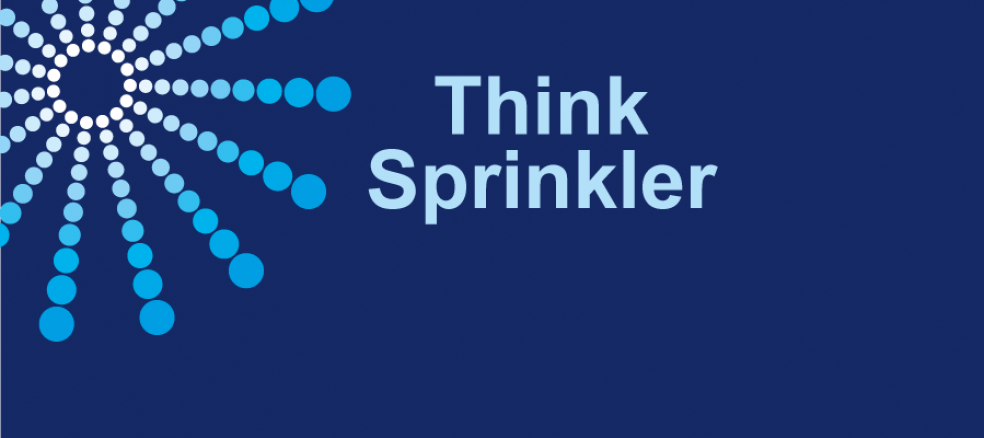
Fire Sprinkler Week targets businesses
Devon & Somerset Fire & Rescue Service is joining with Fire and Rescue Services across the UK in supporting Fire Sprinkler Week 2015, taking place from 16-22 March.
This is the second annual sprinkler awareness campaign undertaken by Fire and Rescue services and this year is focusing on the way that fitting sprinklers can help businesses and education, by reducing the impact of a fire.
Lee Howell, Chief Fire Officer said: “Devon & Somerset fully support this campaign as sprinklers save lives, protect property, promote prosperity and contribute to the community health, safety and wellbeing. There is an increasing body of evidence worldwide of fires being controlled and extinguished by sprinklers.”
Paul Bray, Community Safety Manager said “The benefits of a sprinkler far exceed the cost of installation and maintenance, as it has been documented that around 80% of businesses do not recover after a major fire, and this has an impact not only on the company itself, but on its employees, customers and suppliers.
“As businesses look to remain competitive in a challenging economic climate, it becomes more important than ever for them to ensure that their key resources are protected, allowing them to continue operating after a fire. Sprinklers allow for rapid re-occupation and use of the building, sometimes on the same day.”
Dispelling the myths about sprinklers
Myth: All our sprinklers will go off every time someone burns the toast, damaging my stock and buildings.
Truth: Each sprinkler head is set to operate individually, and it will only be triggered to spray water onto a fire when it reaches its predetermined operating temperature. The predetermined temperature varies, but it’s often around 68°c. That’s 11°c higher than the highest temperature ever recorded in Death Valley, California, and would be hot enough to fry an egg on the pavement.
If a fire does start in your business, only the sprinklers in the immediate area of the fire will open – all the others remain closed. Don’t believe the Hollywood action films that show the hero flooding an entire building by holding a lighter to a single sprinkler, it just doesn’t happen in real life!
Myth: Sprinklers are unreliable aren’t they?
Truth: No, they are very reliable: accidental discharge due to manufacturing defects is 1 in 14million (per year of service). They’ve been proven in use for well over 100 years, during which time they have a 99% success rate worldwide. There are sprinkler systems over 100 years old that are still in full working condition today.
If you’re worried about water damage, it’s worth knowing that in a fire, firefighters often use 15 times more water from hoses to do the same job as a sprinkler does alone.
Myth: Sprinklers are hugely expensive, I can’t afford them.
Truth: Actually, the costs of installing sprinklers works as roughly equivalent to carpeting the same building in new buildings. In UK business properties you can expect to pay in the region of £1.39–£1.85 per square foot to install fire sprinklers (for light to ordinary hazard).
In contrast, damage from fires can cost hundreds of thousands of pounds – sometimes running into millions of pounds. For example, the average cost of an industrial fire is £1,500,000; for a department store it’s £3,000,000 per fire. Even smaller businesses may find the costs are higher than they think: the average cost of a fire in a hairdresser’s is £312,000 per fire, and for a single retail shop the average cost is £355,000 per fire. Losses from fires in buildings protected with sprinklers, in comparison, are estimated to be one-tenth of those in unprotected buildings.
Fitting sprinklers can save you money in some areas – insurers will often offer premium discounts to premises with sprinkler systems, and policy excesses may be lower.
Myth: Sprinklers are ugly and will spoil the look of my building
Truth: Modern sprinklers can be specially designed to meet your needs and are compact and elegant. The public will often be unaware that sprinklers are fitted, with miniature sprinklers (about the size of a 50p piece) available, which can be fitted with ceiling rosettes and painted to match your colour scheme. Concealed sprinklers are almost invisible – they’re recessed, flush with the ceiling, and covered by a flat plate (ideal for clean areas, areas with restricted headroom, or where vandalism is a potential problem).
In fact, including sprinklers in the specification for an unconventional or unusual building design can often offer design freedoms while still achieving Building Regulations compliance cost-effectively. Sprinklers may also mean that you can reduce the amount of visible, portable fire-fighting equipment that you need to have.
Myth: I’ve got all my fire protection in place, it’ll never happen to me…
Truth: Of the 14,600 accidental fires in dwellings and other buildings in 2012/13, 5,700 were caused by electrical distribution and other electrical appliances[8]. And, while you think you might not be a target for arson, there were 9,910 fires started deliberately in 2012/13, with over 3,063 of these in premises including industrial and retail buildings and schools[9].
Myth: Sprinklers only use water – my business has specialist requirements that mean water can’t be used on a fire.
Truth: Sprinklers can now be foam enhanced, to control flammable liquid, chemical and petroleum fires.
Fire Sprinkler Week 2015 is being coordinated by the Chief Fire Officers Association (CFOA). CFOA is campaigning for a legal requirement to fit sprinklers in higher risk premises, such as care homes, schools and other buildings. Laws in England are lagging behind those currently in force in Scotland and Wales, which require sprinklers to be installed in a range of higher-risk buildings.














